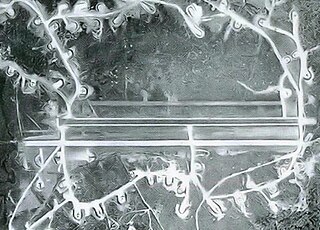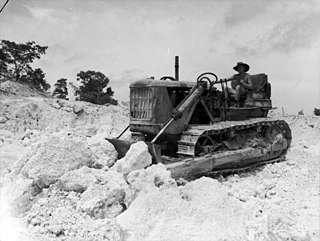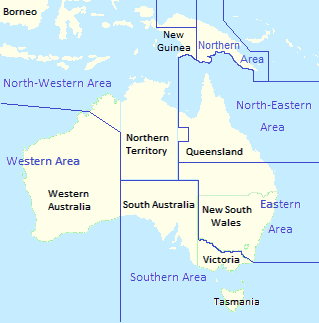
The Australian First Tactical Air Force was formed on 25 October 1944 by the Royal Australian Air Force (RAAF). Its purpose was to provide a mobile force of fighter and ground attack aircraft that could support Allied army and naval units fighting the Empire of Japan in the South West Pacific Area. One of several Allied tactical air forces formed during World War II, it evolved from the RAAF's No. 10 Operational Group, established a year earlier. Following action in the assaults on Aitape and Noemfoor, the group was renamed the First Tactical Air Force to better reflect its size and role. It was beset with morale and leadership issues in early 1945, but recovered to take part in the battles of Tarakan, North Borneo, and Balikpapan. Reaching its peak strength of over 25,000 personnel in July 1945, No. 1 TAF's squadrons operated such aircraft as the P-40 Kittyhawk, Supermarine Spitfire, Bristol Beaufighter, and B-24 Liberator. The formation remained active following the end of hostilities in the Pacific until it was disbanded on 24 July 1946.

D'Entrecasteaux Islands are situated near the eastern tip of New Guinea in the Solomon Sea in Milne Bay Province of Papua New Guinea. The group spans a distance of 160 km (99 mi), has a total land area of approximately 3,100 km2 (1,197 sq mi) and is separated from the Papua New Guinea mainland by the 30 km (19 mi) wide Ward Hunt Strait in the north and the 18 km (11 mi) wide Goschen Strait in the south. D'Entrecasteaux Islands show signs of volcanism.

No. 32 Squadron is a Royal Australian Air Force unit based at RAAF East Sale in Victoria. It currently flies training and transport operations. The squadron was raised in February 1942 for service during World War II. Equipped with Lockheed Hudsons, the squadron was tasked with anti-submarine, anti-shipping operations, bombing and reconnaissance missions in New Guinea. In late 1942, the squadron was withdrawn to Sydney and re-equipped with Bristol Beauforts, which it operated along the east coast of Australia until the war ended. The squadron was disbanded in November 1945, but was re-formed in 1989 and currently operates King Air 350s.

Goodenough Island in the Solomon Sea, also known as Nidula Island, is the westernmost of the three large islands of the D'Entrecasteaux Islands in Milne Bay Province of Papua New Guinea. It lies to the east of mainland New Guinea and southwest of the Trobriand Islands. It is roughly circular in shape, measuring 39 by 26 kilometres with an area of 687 square kilometres (265 sq mi) and a shoreline of 116 kilometres (72 mi). From a coastal belt varying in width from 2 to 10 kilometres in width, the island rises sharply to the summit of Mount Vineuo, 2,536 metres (8,320 ft) above sea level, making it one of the most precipitous islands in the world. The small outlier Wagifa Island lies to the south-east of the island, and is included within Goodenough's administration.

No. 84 Squadron was a Royal Australian Air Force (RAAF) fighter squadron of World War II. It was established in February 1943 and was part of the defences of the Torres Strait area from April 1943 until May the next year. After being withdrawn from the Torres Strait the squadron was reduced to a cadre until May 1945, when it began to receive new aircraft. No. 84 Squadron was disbanded in January 1946.

No. 100 Squadron is a Royal Australian Air Force (RAAF) historic aircraft display squadron. It was originally formed as a bomber and maritime patrol squadron that operated during World War II. Raised in early 1942 from the remnants of a British unit that had been destroyed in Malaya, the squadron flew Bristol Beauforts from bases in Queensland and New Guinea, undertaking torpedo- and level-bombing sorties against Japanese targets in the Pacific theatre. Following the conclusion of hostilities, the squadron was disbanded in August 1946. It was reformed as the Air Force Heritage Squadron in January 2021 to operate airworthy warbirds.

Camden Airport is an aerodrome located on the outskirts of Sydney 1 nautical mile northwest of Camden, New South Wales, Australia. The airport is located approximately 60 km (37 mi) from Sydney's central business district. Camden is used as a general aviation overflow airport for the busier Bankstown Airport; and provides facilities for gliding and ballooning. The aerodrome has one grass- and one paved runway and two glider airstrips. It is in the south-west corner of the designated Sydney flight training area.

Madang Airport, is an airport located in Madang, Papua New Guinea.

Gurney Airport is an airport serving Alotau in the Milne Bay Province of Papua New Guinea (PNG).
Jacquinot Bay Airport is an airport near Jacquinot Bay in the East New Britain Province on the island of New Britain in Papua New Guinea. The airstrip was liberated by the Australian Army in 1944, and an airstrip was built by 1945. There is no scheduled airline service.
Losuia Airport is an airport in Losuia, on the island of Kiriwina, Papua New Guinea.
Momote Airport is an airport on Los Negros Island in the Admiralty Islands, Papua New Guinea. It also serves Manus Island, which is connected to Los Negros by a bridge.
Hughes Airfield is an airfield in the Northern Territory of Australia located in the locality of Hughes. It was constructed during World War II for military use. The airfield now functions as a base for aerial firefighting aircraft to protect the outer rural suburbs of Darwin.

The Port Moresby Airfield Complex was a World War II military airfield complex, built near Port Moresby in the Territory of Papua and New Guinea. It was used during the Battle of New Guinea as a base of Allied air operations primarily in 1942 and early 1943. It later became a support base as the battle moved to the north and western part of New Guinea. It was closed and the facility turned over to civil authorities after the end of the war in September 1945.

No. 71 Wing was a Royal Australian Air Force (RAAF) wing of World War II. It was formed in February 1943 at Milne Bay, Papua New Guinea, as part of No. 9 Operational Group. The wing initially comprised two squadrons of P-40 Kittyhawks, one of Lockheed Hudsons, and one of Bristol Beauforts. The wing's mainstay soon became the Beaufort, which eventually equipped five squadrons attached to the formation. No. 71 Wing took part in the New Guinea campaign under the auspices of No. 9 Group, before transferring to No. 10 Operational Group for the Western New Guinea campaign during 1944. It then returned to the control of Northern Command to support Australian ground forces in the Aitape–Wewak campaign, and completed its final combat mission only hours before the Japanese surrender in August 1945. No. 71 Wing remained in New Guinea following the war and was disbanded in January 1946.

The Battle of Goodenough Island, also known as Operation Drake, was a battle of the Pacific campaign of World War II. The Allies landed on Goodenough Island, Papua, and clashed with a Japanese Kaigun Rikusentai. The Japanese troops had been stranded on the island during the Battle of Milne Bay in late August 1942. "Drake Force", consisting of the Australian 2/12th Battalion and attachments, landed on the southern tip of Goodenough Island at Mud Bay and Taleba Bay on 22 October, tasked with denying the Japanese use of the island prior to the Buna campaign. Following a short but intense fight, the Japanese forces withdrew to Fergusson Island on 27 October. After the battle, Goodenough Island was developed into a major Allied base for operations later in the war.

No. 73 Wing was a Royal Australian Air Force (RAAF) wing of World War II. It was formed in February 1943 at Port Moresby, Papua New Guinea, as part of No. 9 Operational Group. The wing initially comprised three attack squadrons flying CAC Wirraways, Douglas Bostons, and Bristol Beaufighters, with which it took part in the New Guinea campaign until mid-year. It was then reorganised with three fighter squadrons operating P-40 Kittyhawks and Supermarine Spitfires; in this form it saw action in the New Britain and Admiralty Islands campaigns through 1943–44. The wing was disbanded at Los Negros in August 1944, and by the beginning of 1945 its squadrons had been absorbed into other RAAF wings under No. 10 Operational Group.

No. 77 Wing was a Royal Australian Air Force (RAAF) wing of World War II. It formed part of No. 10 Operational Group at its establishment in November 1943, when it comprised three squadrons equipped with Vultee Vengeance dive bombers. No. 77 Wing commenced operations in early 1944, flying out of Nadzab, Papua New Guinea. Soon afterwards, however, the Vengeance units were withdrawn from combat and replaced with squadrons flying Douglas Bostons, Bristol Beaufighters and Bristol Beauforts. The wing saw action in the assaults on Noemfoor, Tarakan, and North Borneo, by which time it was an all-Beaufighter formation made up of Nos. 22, 30 and 31 Squadrons. It was to have taken part in the Battle of Balikpapan in June 1945, but unsuitable landing grounds meant that the Beaufighter units were withdrawn to Morotai, sitting out the remainder of the war before returning to Australia, where they disbanded, along with the wing headquarters, in 1946.

No. 5 Airfield Construction Squadron (5ACS) was a Royal Australian Air Force (RAAF) construction squadron. The unit was first formed in July 1942 and served in the New Guinea Campaign and Borneo Campaign during World War II. The squadron was one of only a few RAAF airfield construction units to be retained at the end of the war, and formed part of Australia's contribution to the occupation of Japan from 1945 until it was disbanded in June 1949. 5ACS was re-raised in August 1951 and worked on several RAAF airfields in Australia. It also provided small detachments of engineers to support RAAF deployments to South Vietnam and Thailand during the Vietnam War. The squadron was the RAAF's only airfield construction unit from 1961 onward, and was disbanded in December 1974.

Northern Command was one of several geographically based commands raised by the Royal Australian Air Force (RAAF) during World War II. Established in April 1944, it evolved from No. 9 Operational Group, which had been the RAAF's primary mobile formation in the South West Pacific theatre since September 1942, but had lately become a garrison force in New Guinea. Northern Command was headquartered initially at Milne Bay and then, from August 1944, in Madang. It conducted operations in New Guinea, New Britain, and Bougainville until the end of the war. Re-designated Northern Area in December 1945, it was headquartered in Port Moresby from March 1946 and disbanded in February 1947.
















